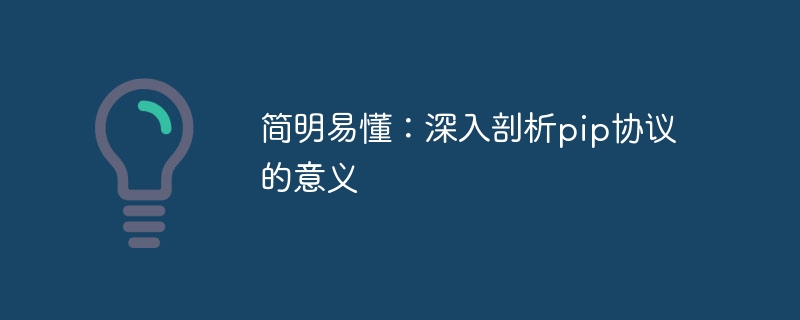Home >Backend Development >Python Tutorial >Concise and easy to understand: in-depth analysis of the meaning of pip protocol
Concise and easy to understand: in-depth analysis of the meaning of pip protocol
- 王林Original
- 2024-02-02 13:10:221270browse

In-depth analysis of the meaning of the pip protocol requires specific code examples
Introduction:
In the Python world, pip (i.e. pip install) is our installation and The preferred way to manage third-party libraries. It is a Python package management tool. It is widely used in the development process because of its simplicity, efficiency, ease of use and convenience. This article will deeply analyze the meaning of the pip protocol, demonstrate the important role and usage of pip through specific code examples, and help readers better understand and use pip.
1. The meaning of pip protocol
The pip protocol is a specification for communication between the pip tool and the Python Package Index PyPI (Python Package Index). It defines how the pip tool finds, downloads and installs third-party libraries. An in-depth understanding of the meaning of the pip protocol will help us better understand the principles behind it when using the pip tool, and conduct related debugging and troubleshooting when encountering problems.
The significance of the pip protocol can be summarized as follows:
- Provides a standard way to access and manage Python packages. The pip tool interacts with PyPI by following the pip protocol, helping us to easily find, install and upgrade third-party libraries. This greatly simplifies our development process, eliminating the need to manually download and manage library files, and reducing the possibility of errors.
- Through the pip protocol, we can use simple commands to manage third-party libraries. The pip tool provides a set of advanced commands, such as installation, uninstallation, update, listing installed libraries, etc., allowing us to process library files quickly and easily. This simple command line operation saves unnecessary time and effort.
- The pip protocol makes publishing and sharing libraries more convenient and efficient. With the support of the pip tool and PyPI, we can share our own developed libraries with other developers, and we can also easily download and use libraries shared by other developers from PyPI. In this way, we can better utilize and participate in the resources and contributions of the Python community.
2. Specific code examples
In order to better understand the meaning of the pip protocol, some specific code examples will be shown next to demonstrate how the pip tool operates based on the pip protocol.
-
Install third-party libraries:
pip install requests
With the above simple command, we can install the requests library. The pip tool will automatically find and download the latest version, and then install it. This process is based on the pip protocol.
-
Uninstall the installed library:
pip uninstall requests
With the above command, we can uninstall the requests library from our Python environment. It is also based on the pip protocol.
-
Update the installed library:
pip install --upgrade requests
With the above command, we can upgrade the installed requests library to the latest version. This is also inseparable from the support of the pip protocol.
-
List installed libraries:
pip list
With the above command, we can list the installed libraries and their version information in the current Python environment. This is to obtain relevant information through the pip protocol.
Through the above specific code examples, we can clearly see how the pip tool performs various operations based on the pip protocol. It simplifies our management and use of third-party libraries, allowing us to program Python more efficiently.
Summary:
The pip protocol is crucial for us to develop using Python. Through the cooperation of pip tool and pip protocol, we can easily access and manage third-party libraries and improve our development efficiency. This article helps readers better understand and become familiar with the use of the pip tool through an in-depth analysis of the meaning of the pip protocol and specific code examples. In practice, you can try more pip commands to further explore and discover many other useful features and functions of the pip protocol.
The above is the detailed content of Concise and easy to understand: in-depth analysis of the meaning of pip protocol. For more information, please follow other related articles on the PHP Chinese website!

